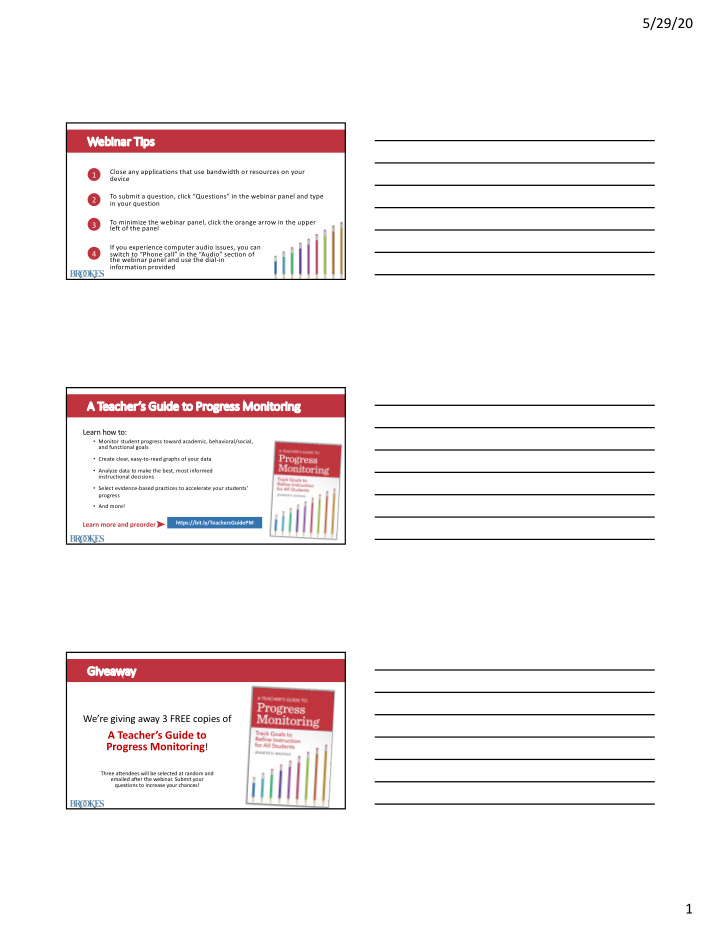



5/29/20 We Webinar Tips Close any applications that use bandwidth or resources on your 1 device To submit a question, click “Questions” in the webinar panel and type 2 in your question To minimize the webinar panel, click the orange arrow in the upper 3 left of the panel If you experience computer audio issues, you can 4 switch to “Phone call” in the “Audio” section of the webinar panel and use the dial-in information provided A A Teach cher’s Guide to o Prog ogress Mon onitor oring Learn how to: • Monitor student progress toward academic, behavioral/social, and functional goals • Create clear, easy-to-read graphs of your data • Analyze data to make the best, most informed instructional decisions • Select evidence-based practices to accelerate your students’ progress • And more! Learn more and preorder ➤ https://bit.ly/TeachersGuidePM Gi Giveaway We’re giving away 3 FREE copies of A Teacher’s Guide to Progress Monitoring ! Three attendees will be selected at random and emailed after the webinar. Submit your questions to increase your chances! 1
5/29/20 Self-Determination through Goal Setting Dr Dr. Je Jennifer N. N. Mah ahdavi vi Webinar Objectives: • Define self-determination (SD) and discuss how goal setting & choice-making supports its development • Review evidence-based practices to support goal setting for individuals of diverse abilities and age ranges • Design procedures to teach children with or without disabilities to set their own goals/ make choices Soci Social Distanci cing to o Se Self-De Deter ermina nation • Children are home; parents are mediating education • Online learning may not “fit” the needs of • Young children • Individuals with some disabilities • Restrictions due to the pandemic add to • Anxiety • Feeling out-of-control • Sense of confusion • Helping children take charge of each day by setting and working toward a goal could help relieve anxiety and increase productivity– in both students and adults! Se Self-De Deter ermina nation: n: Wha hat and nd Why • Skills & traits that lead to more independent living (Wehmeyer, 2015) • “Academic enablers” that support success (Gresham, 2015) • Low SD è poor future outcomes • Learned helplessness (Shogren et al., 2017; Sands & Doll, 1996) • Poor money management (Wehmeyer, 1994) • Limited social contact (Wehmeyer & Abery, 2013) • Benefits include • Improved career & employment options • Increased community engagement and social skills • Wehmeyer, Shogren & Seo, 2015 • Increased motivation and satisfaction with work or life choices (Shogren et al., 2017; Pelletier & Joussemen, 2017; Rowe et al., 2015) 2
5/29/20 El Elements of SD Self-Evaluation & Goal Setting Self-Reinforcement Self-Determination Self-Monitoring Choice Making Wh What stops children from developing SD? Faster/easier for adults to do it Adults feeling needed Kindness/good intentions Low expectations No opportunity to practice skills Building SD Bu SD: Evidence ce-Ba Based Practi ctice ces • Young children • Choice making & self-regulation of feelings/reactions (Palmer et al., 2013) • Problem solving (Tensfeldt, Verroux & Mahdavi, 2018) • Individuals with Intellectual Disability • Set appropriate goals (Kleinert et al., 2014) • Monitoring of self-set goals (Wehmeyer et al., 2013) • Progress monitoring of behavior change (Clouse & Bauer, 2016) • Students with learning or emotional/behavioral disorders • Improve reading ability (Bruhn & Watt, 2012) and vocabulary (Kim et al., 2018) • Increase on-task behavior (Verrall, 2012) • Develop social skills (Peterson et al., 2006) 3
5/29/20 Bu Building SD SD during Virtu tual Learning Make •“What do you want to work on first today” Choices •Hard thing or easy thing? •Lunch, clothing, chores…. Respect •Allow child to explore having agency choices •But within reason • Assist if asked Reinforce • Celebrate Bu Building SD SD during Virtu tual Learning • “What do you want to work on Set goals today?” • Establish feasibility of goal • Model how adults set goals • Checklist Monitor • Sticker chart goals • Graphic organizer • Child-led • Discuss progress Reinforce • Celebrate! Ch Choi oice ce-ma making & & Goal-se setting: g: Consi sider erations • Help the child understand the range of possible options • Ice cream for breakfast is probably NOT a legitimate choice • Long lists of school assignments may be overwhelming • Work with the child to identify his/her strengths as foundation for goal choices • Run around the block vs. run a 5K vs. run a marathon • Give child ownership/agency in the discussion • Use explicit instruction to teach and practice SD skills • I do- We do- You do • Set goals/make choices along with the child 4
5/29/20 We Webinar Objectives Revisited • Define self-determination (SD) and discuss how goal setting & choice-making supports its development • Review evidence-based practices to support goal setting for individuals of diverse abilities and age ranges • Design procedures to teach children with or without disabilities to set their own goals/ make choices • Contact: mahdavi@sonoma.edu Questions ? Sp Speci cial Offer SAVE 20% * at brookespublishing.com Use code COFFEETALK *Expires 6/30/20. Not to be combined with any other discounts or offers. Consumer orders only, please. Excludes BOL training, pre-discounted bundles, and online products such as ASQ Online and AEPSinteractive. 5
5/29/20 Brook Br ookes Cof Coffee Ch Chats ts Looking for more professional development opportunities? http://bit.ly/BrookesCoffeeChats CO COVID-19 19 Resou ource ces • Recommended reading • Downloadable resources • Professional development webinars http://bit.ly/COVID-education 6
Recommend
More recommend